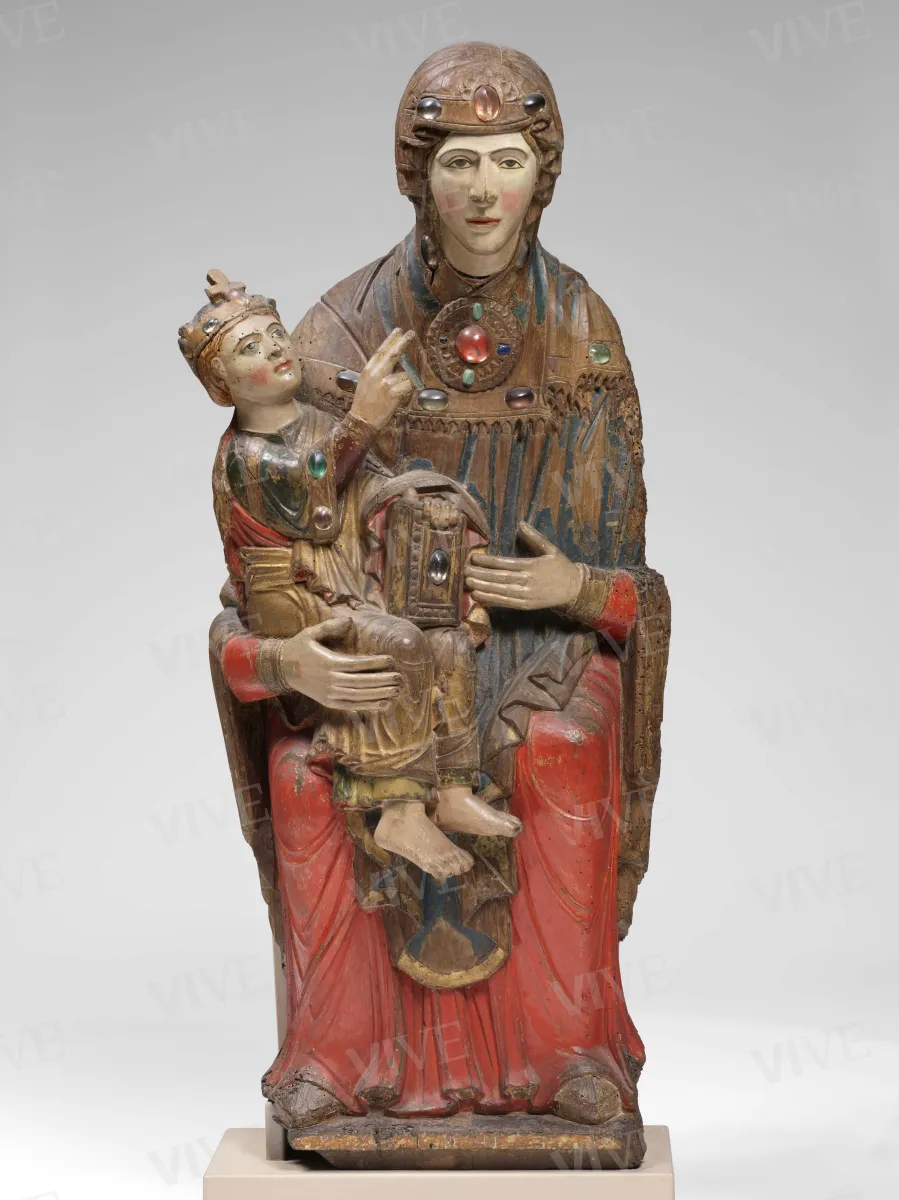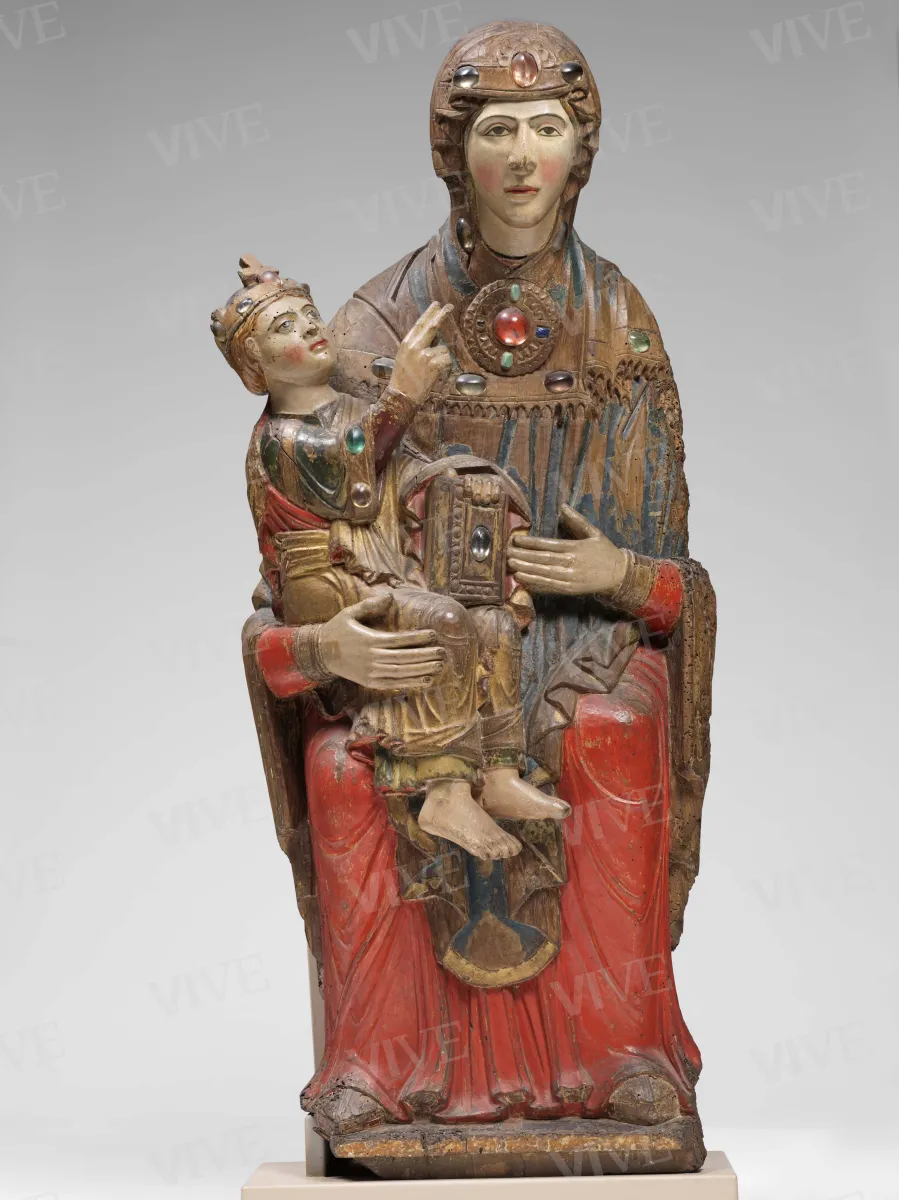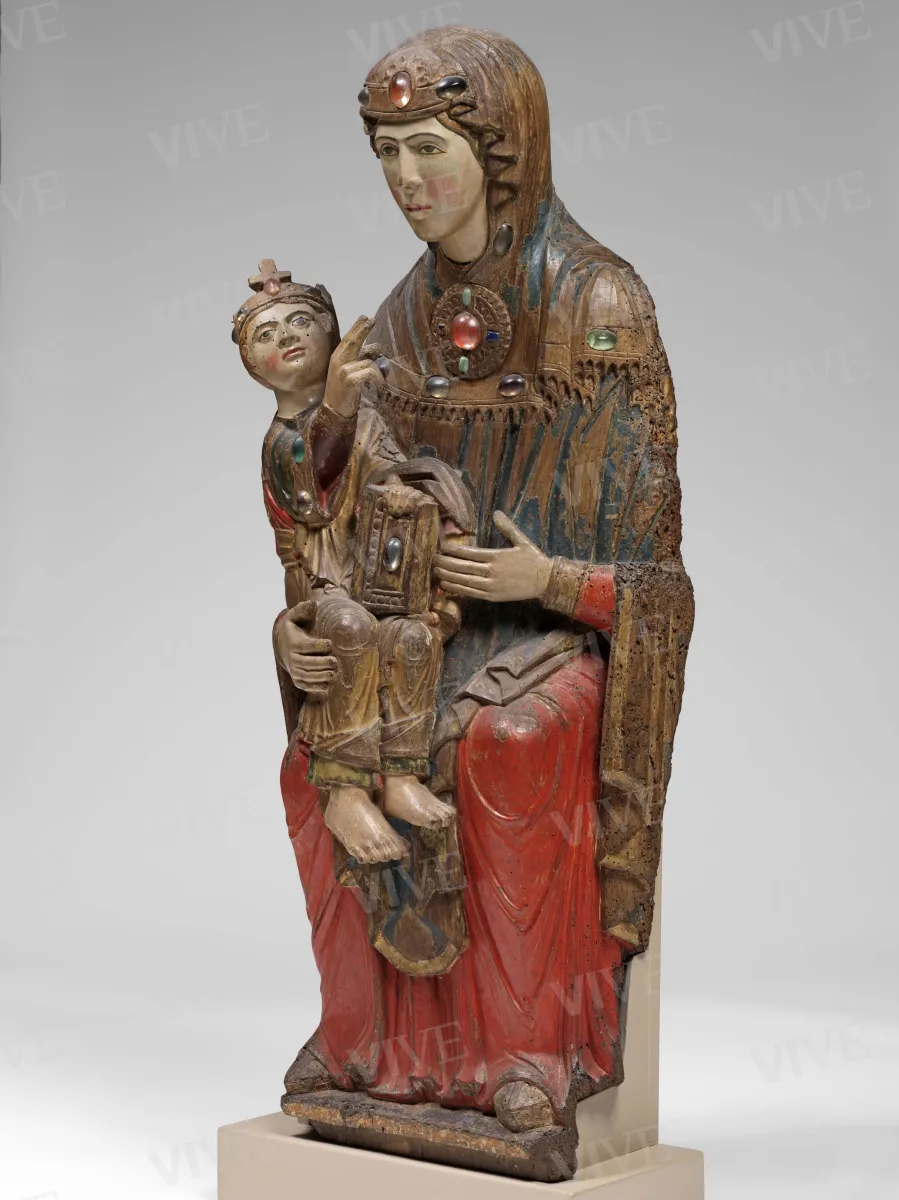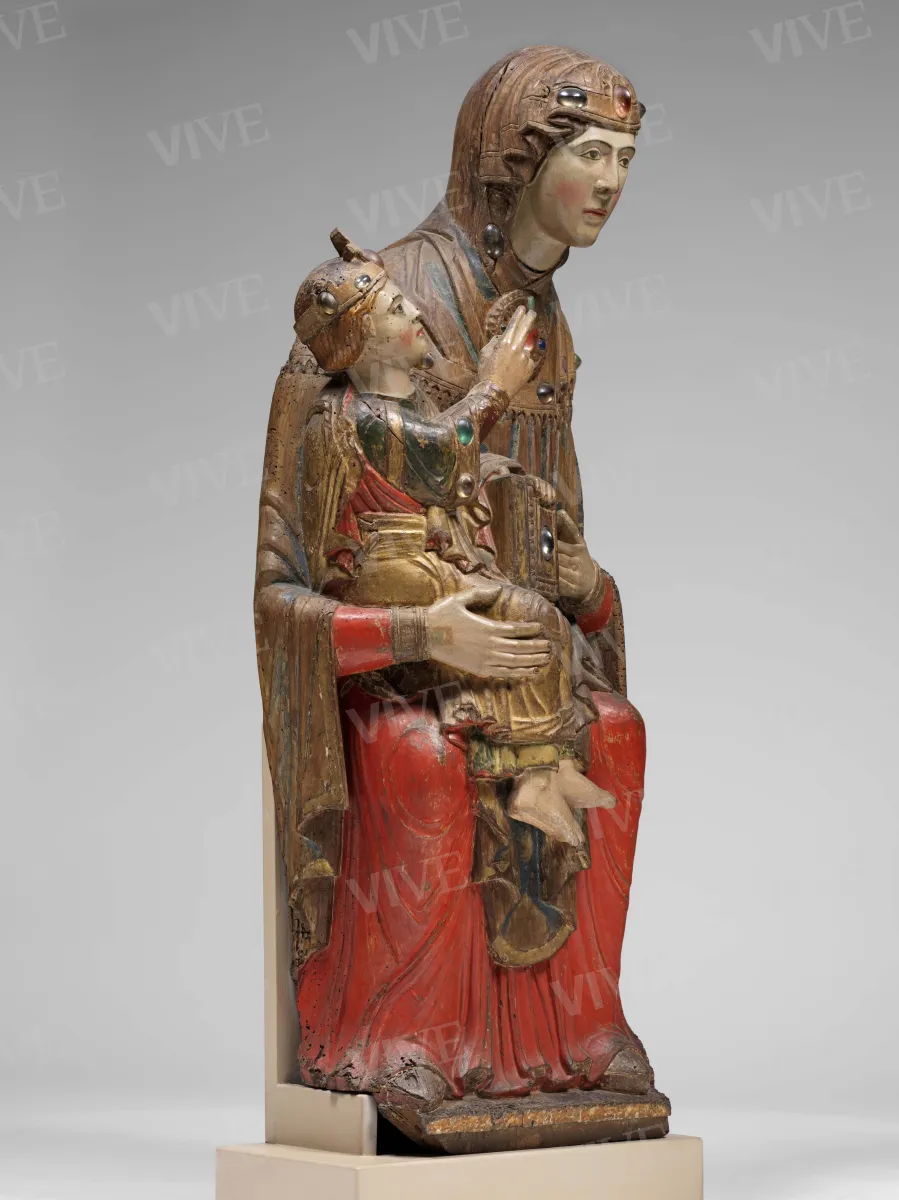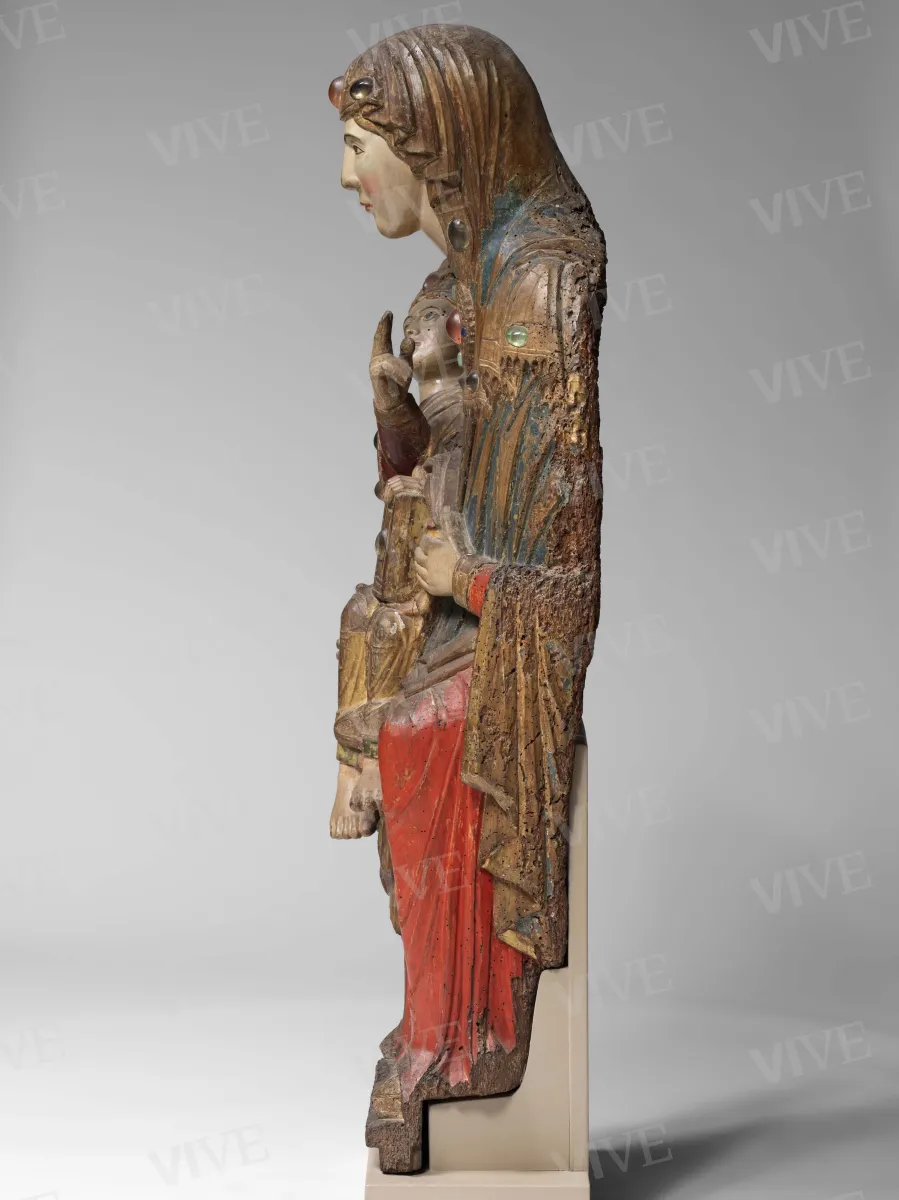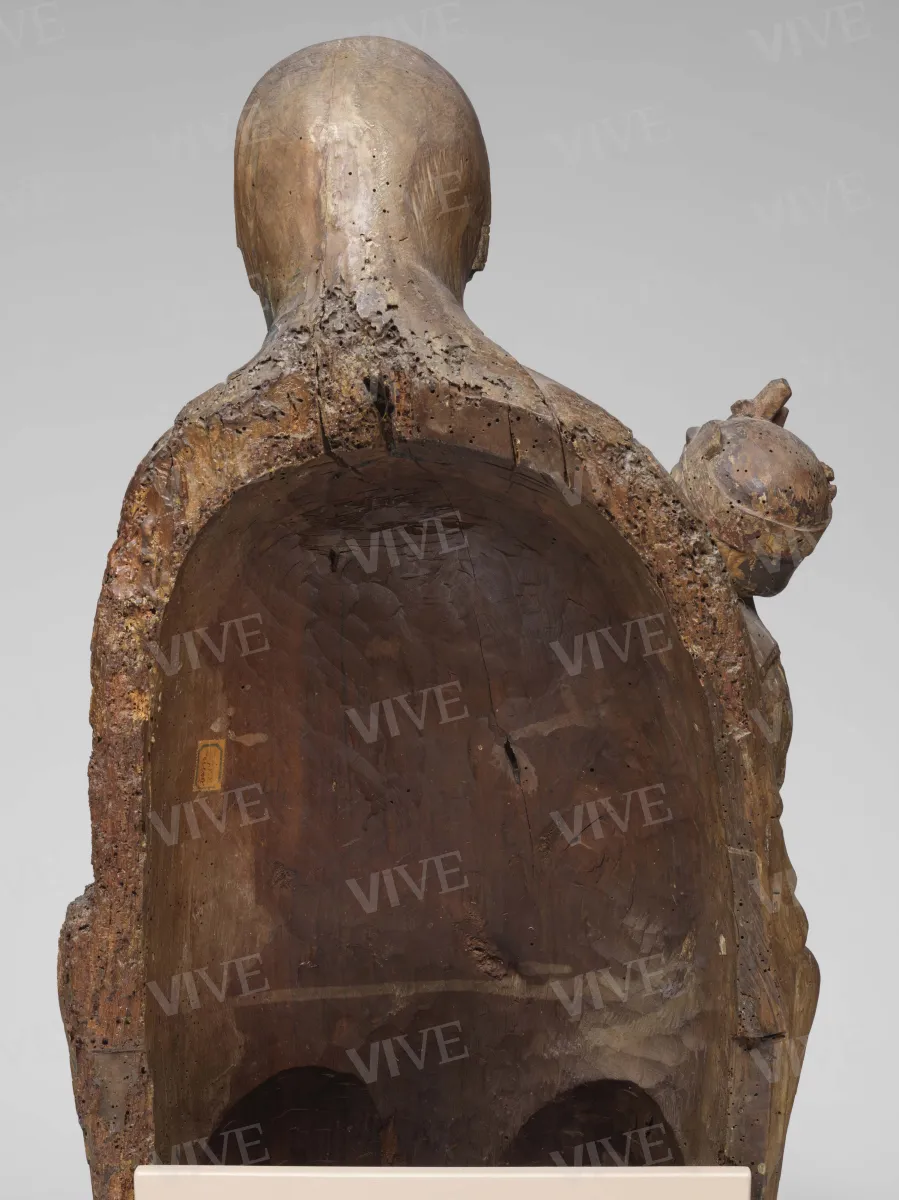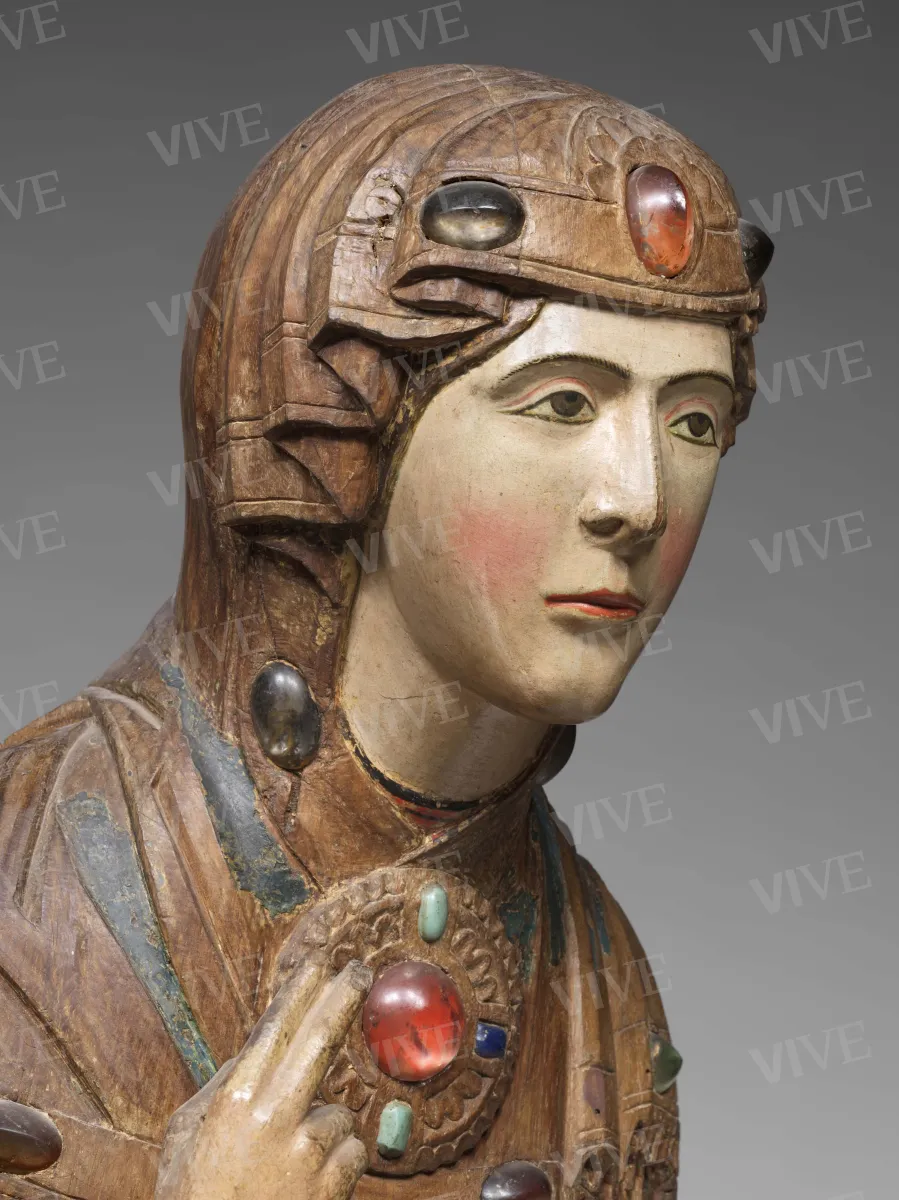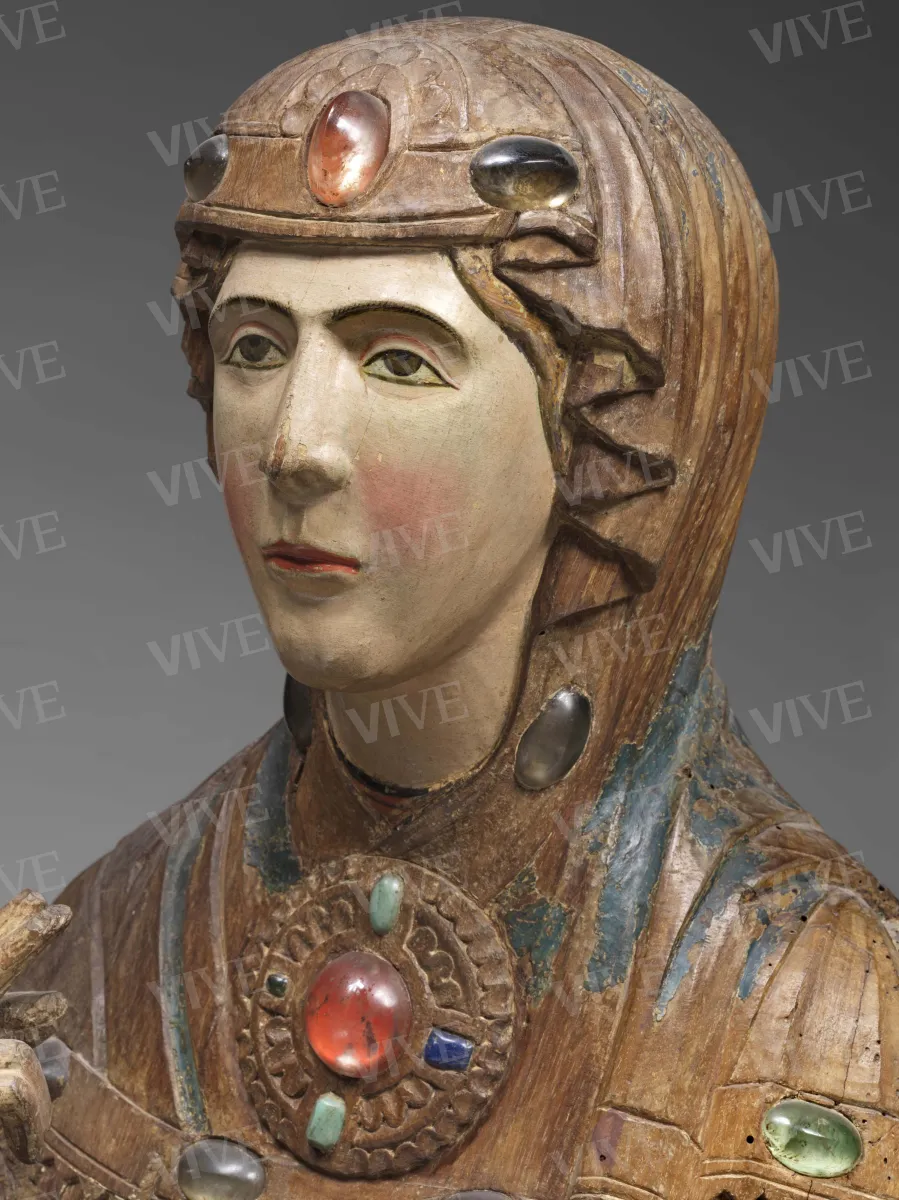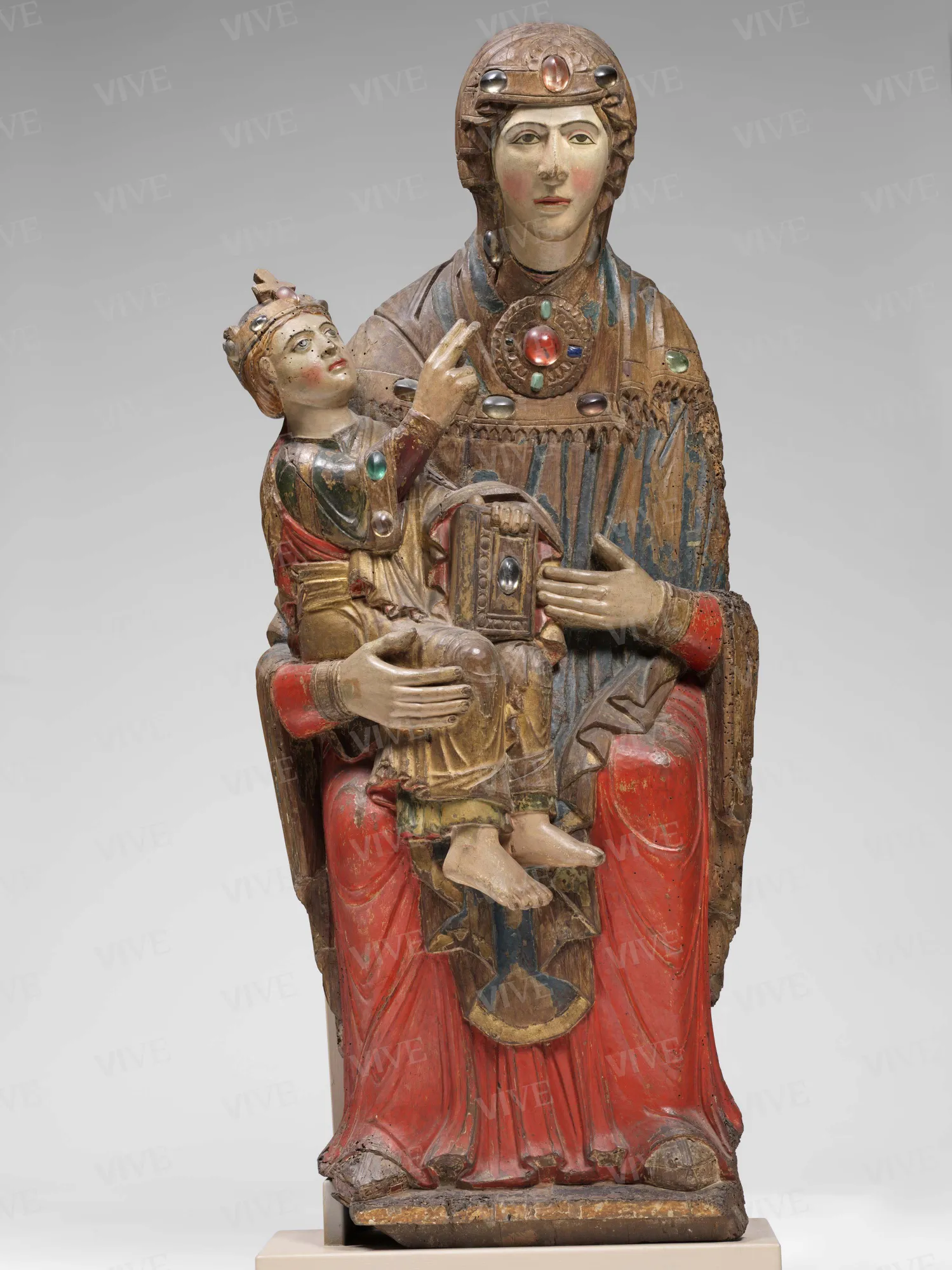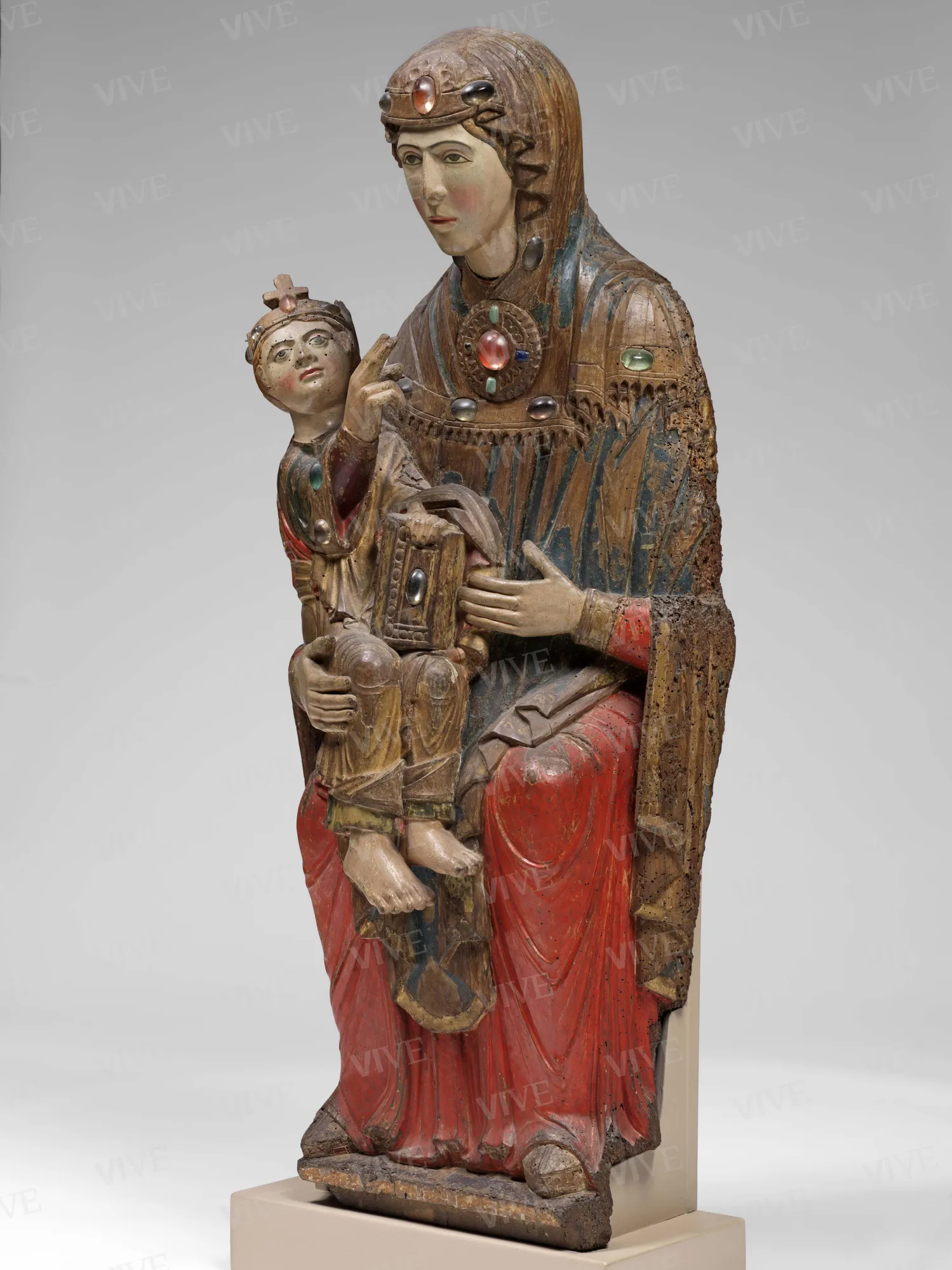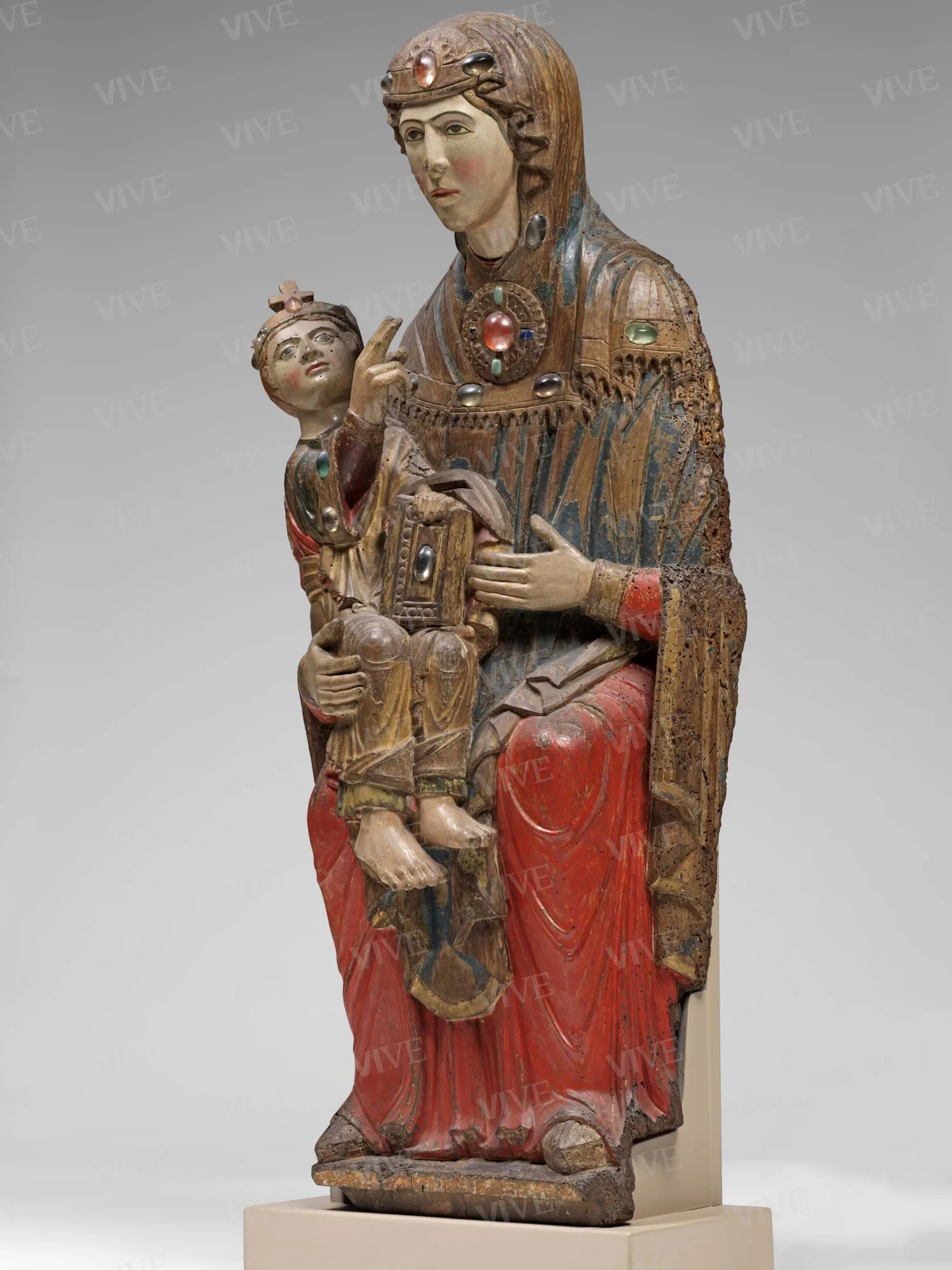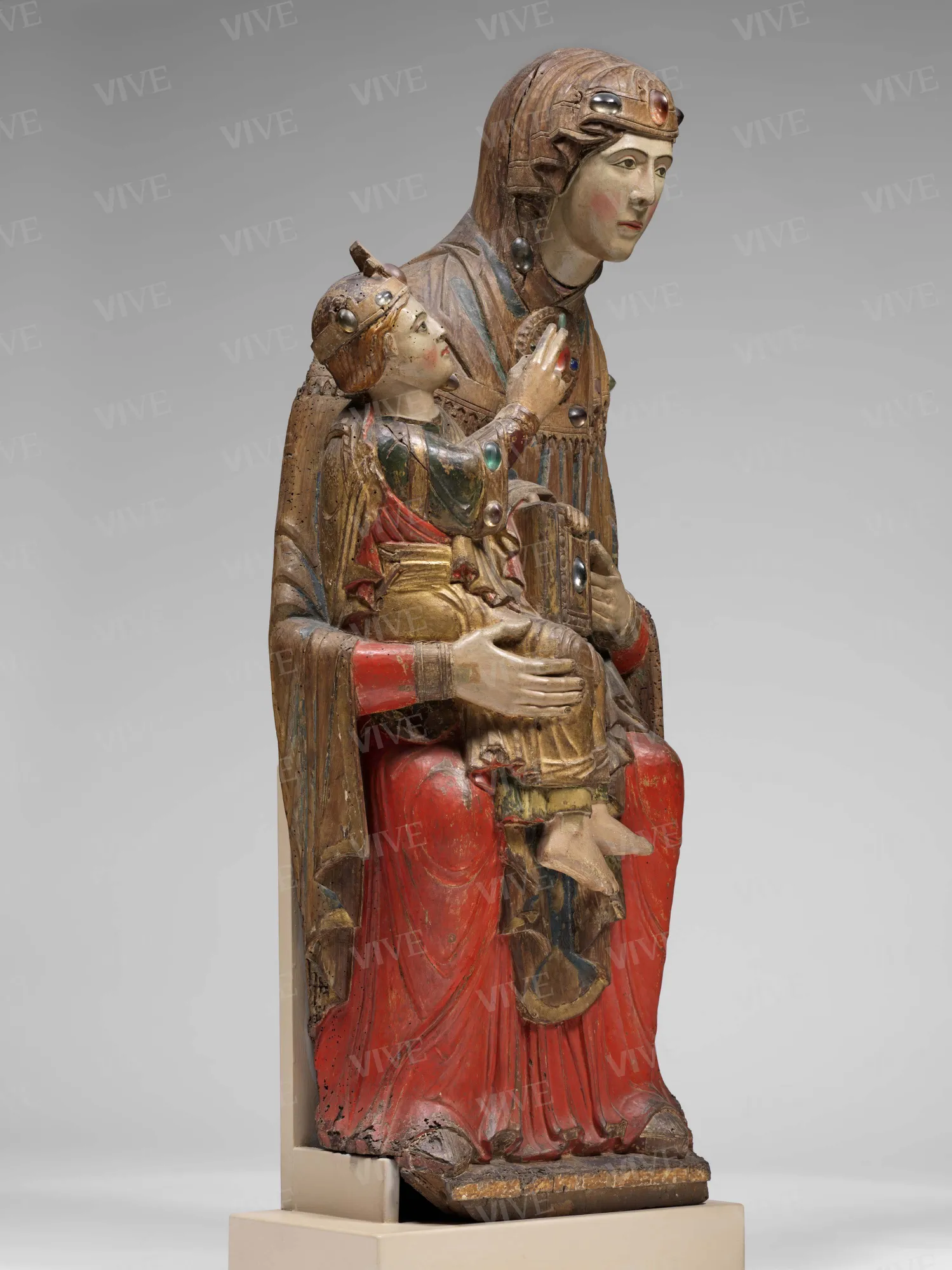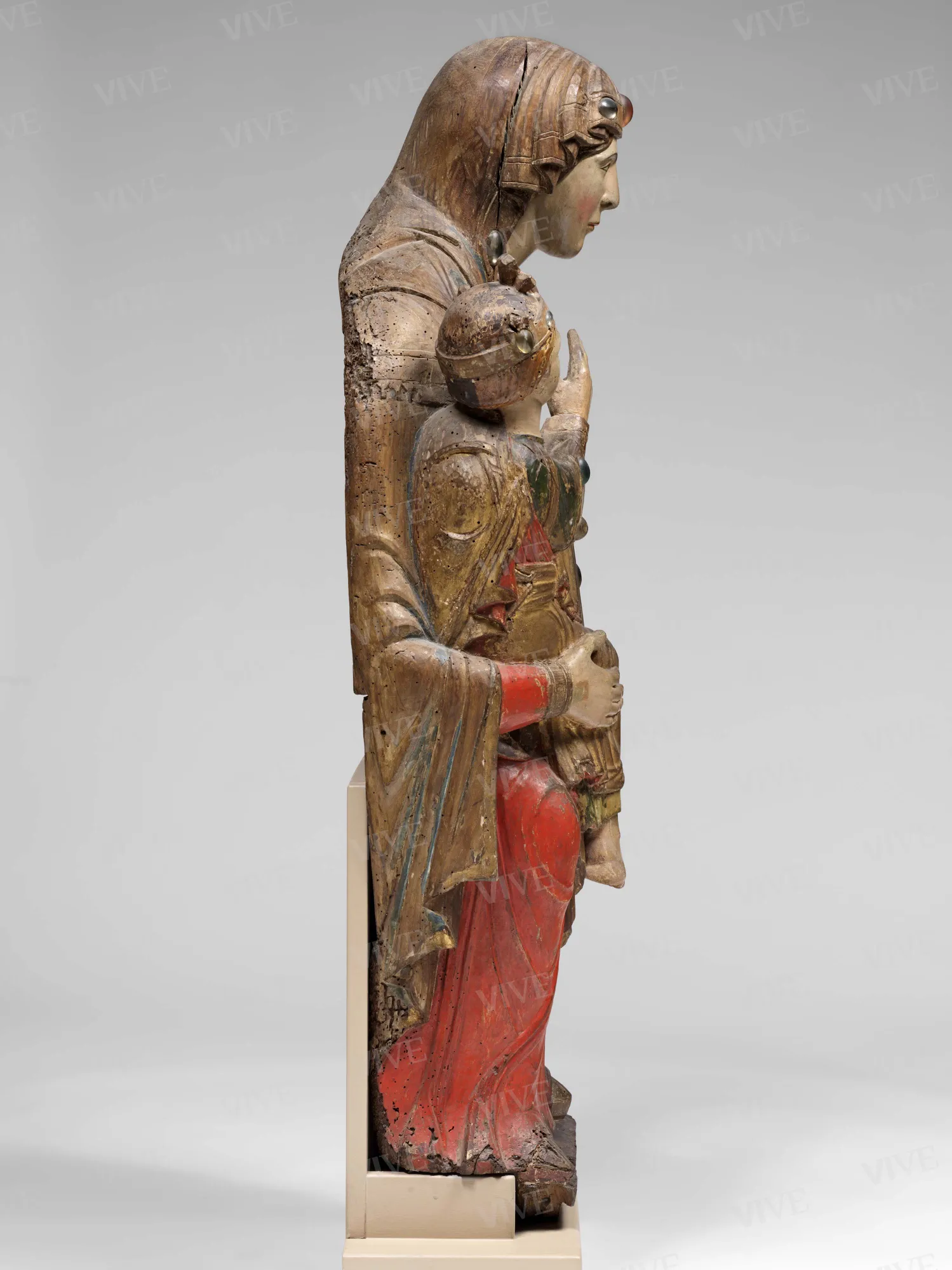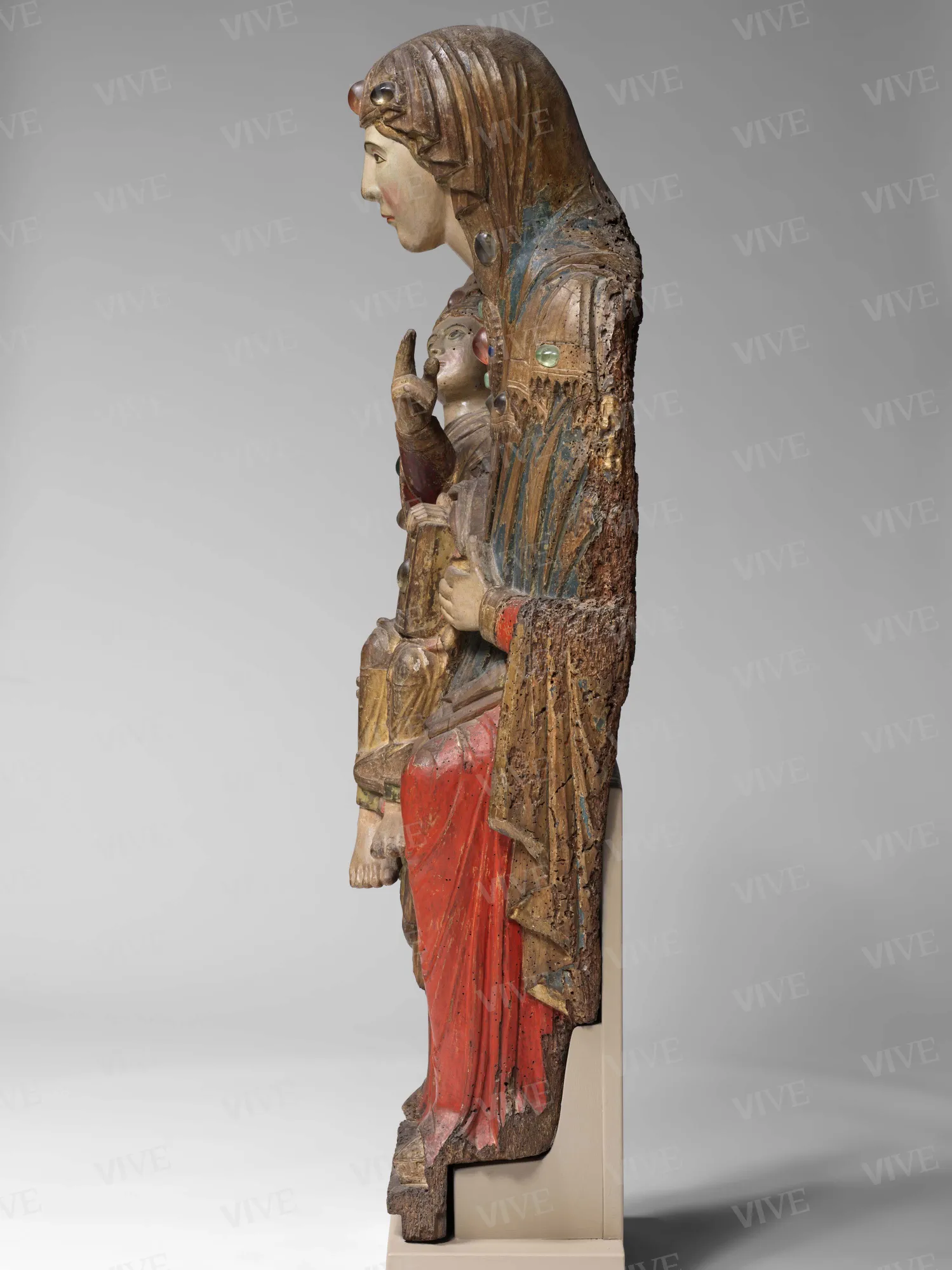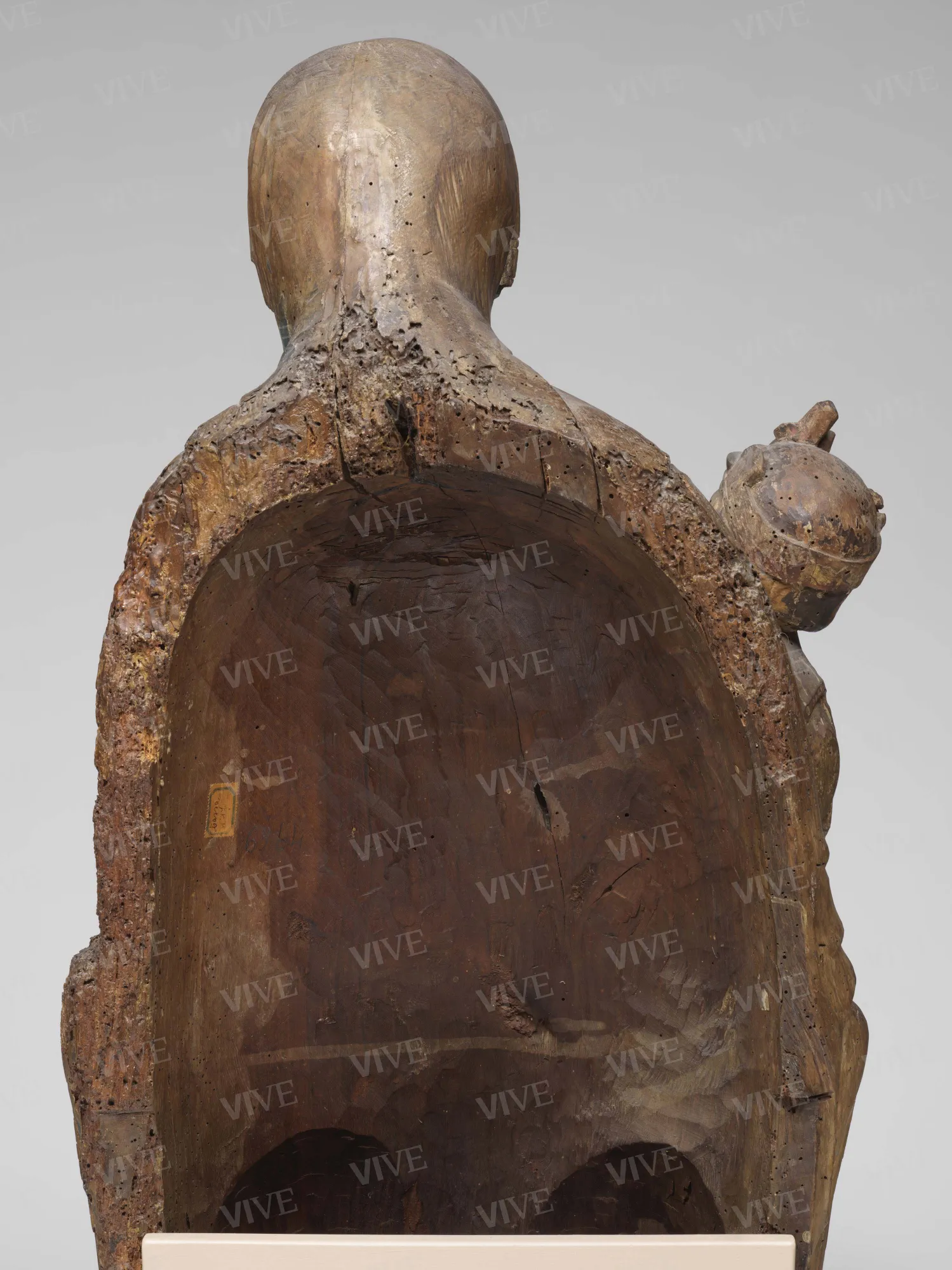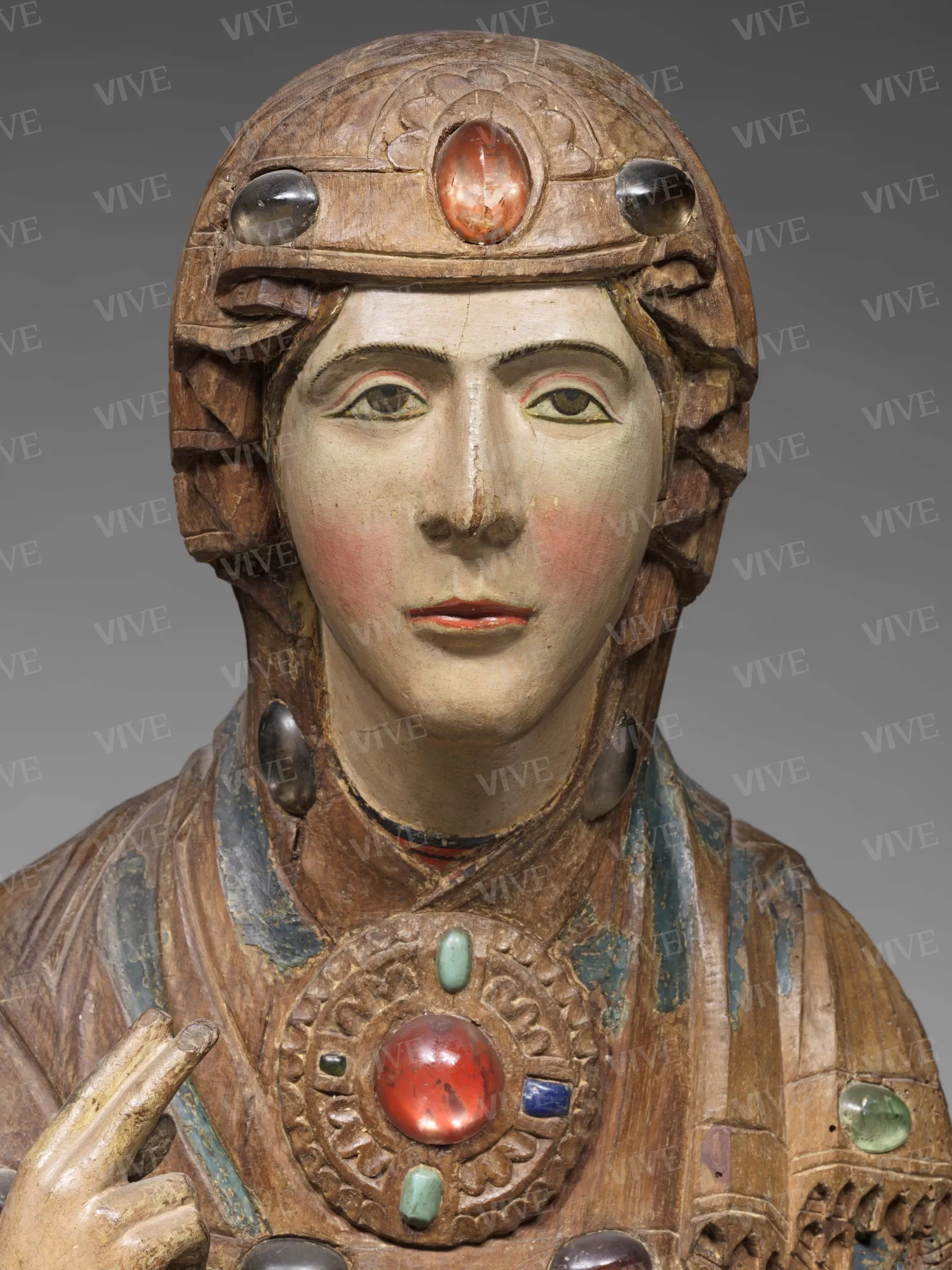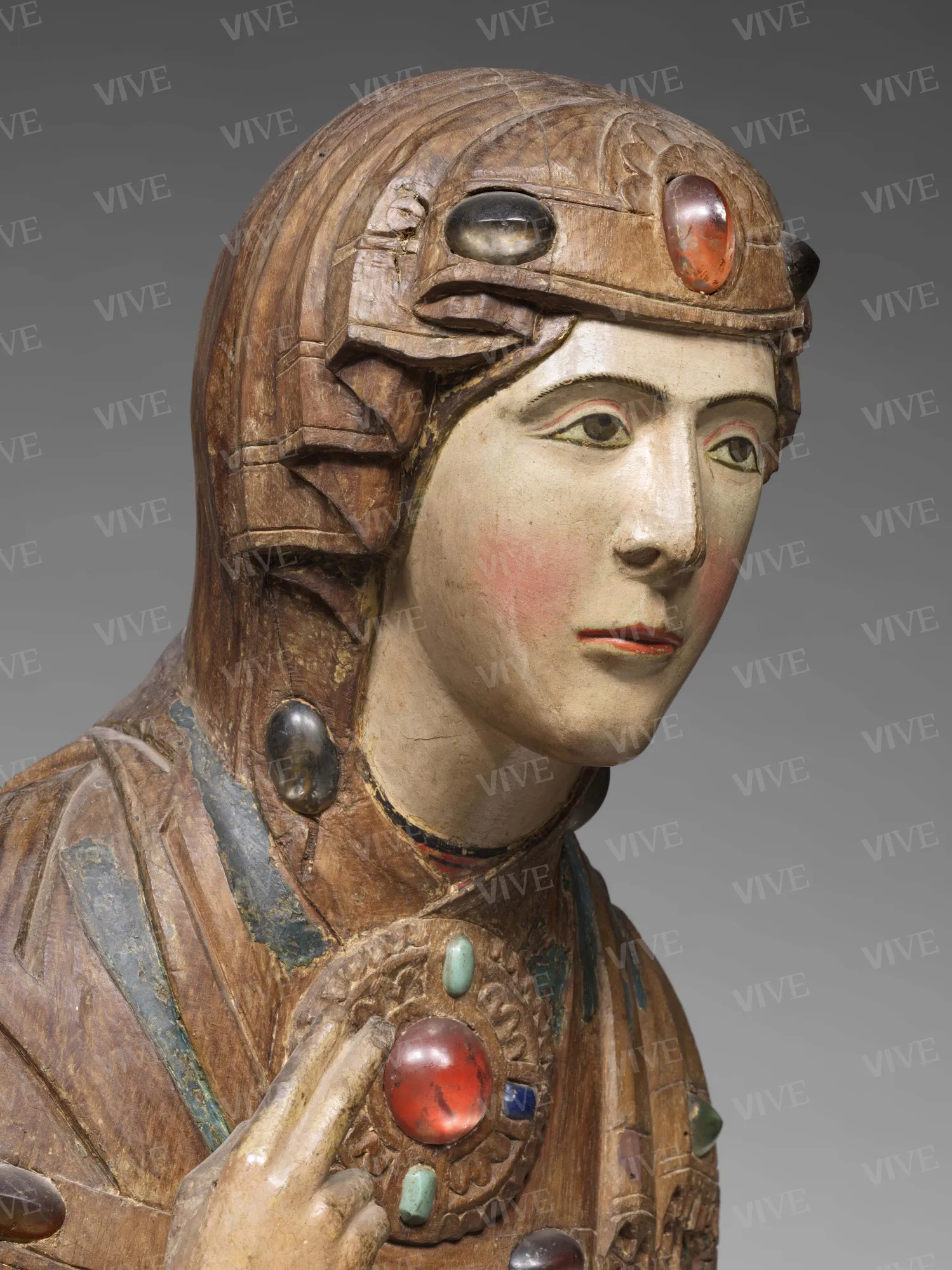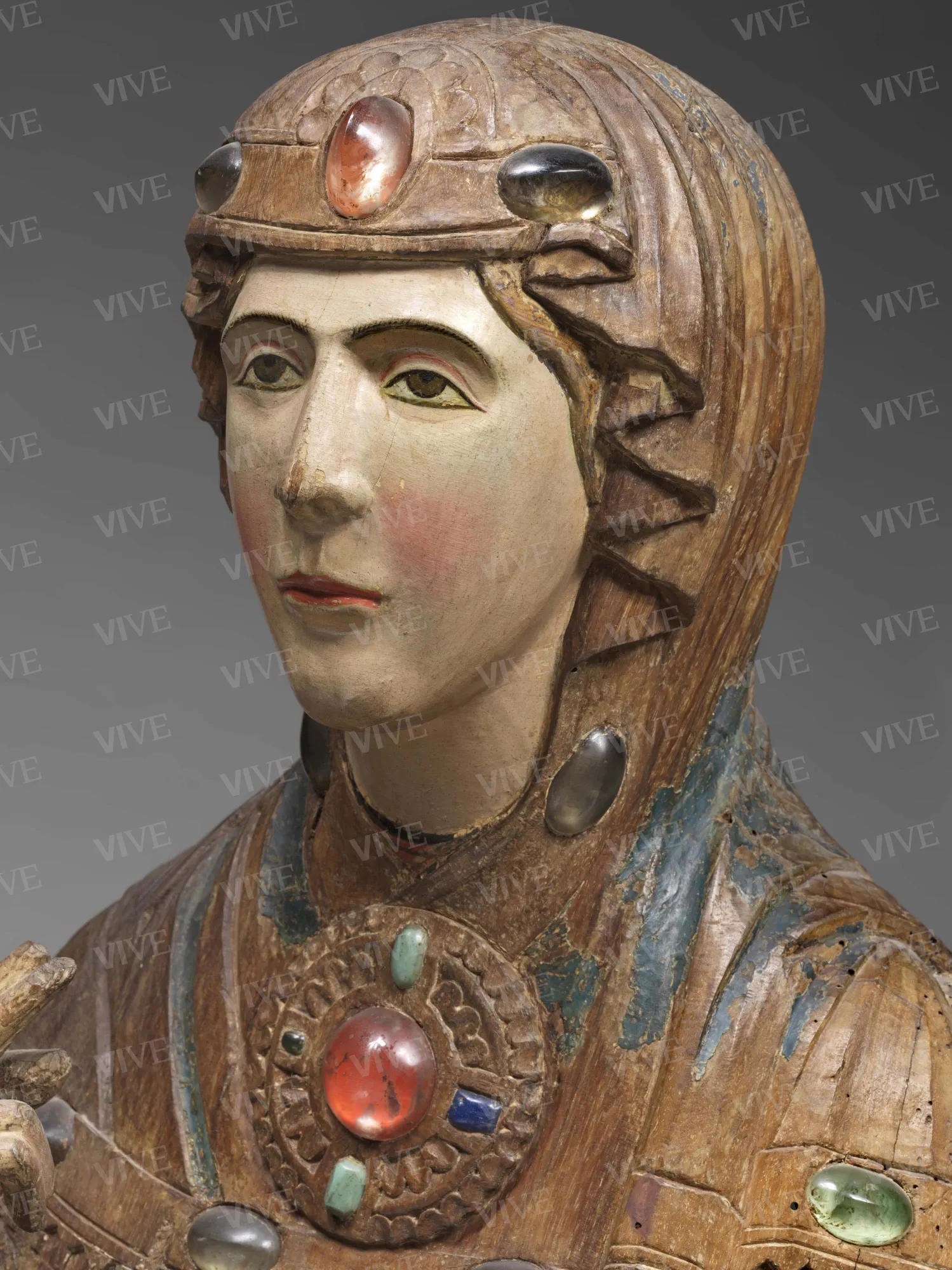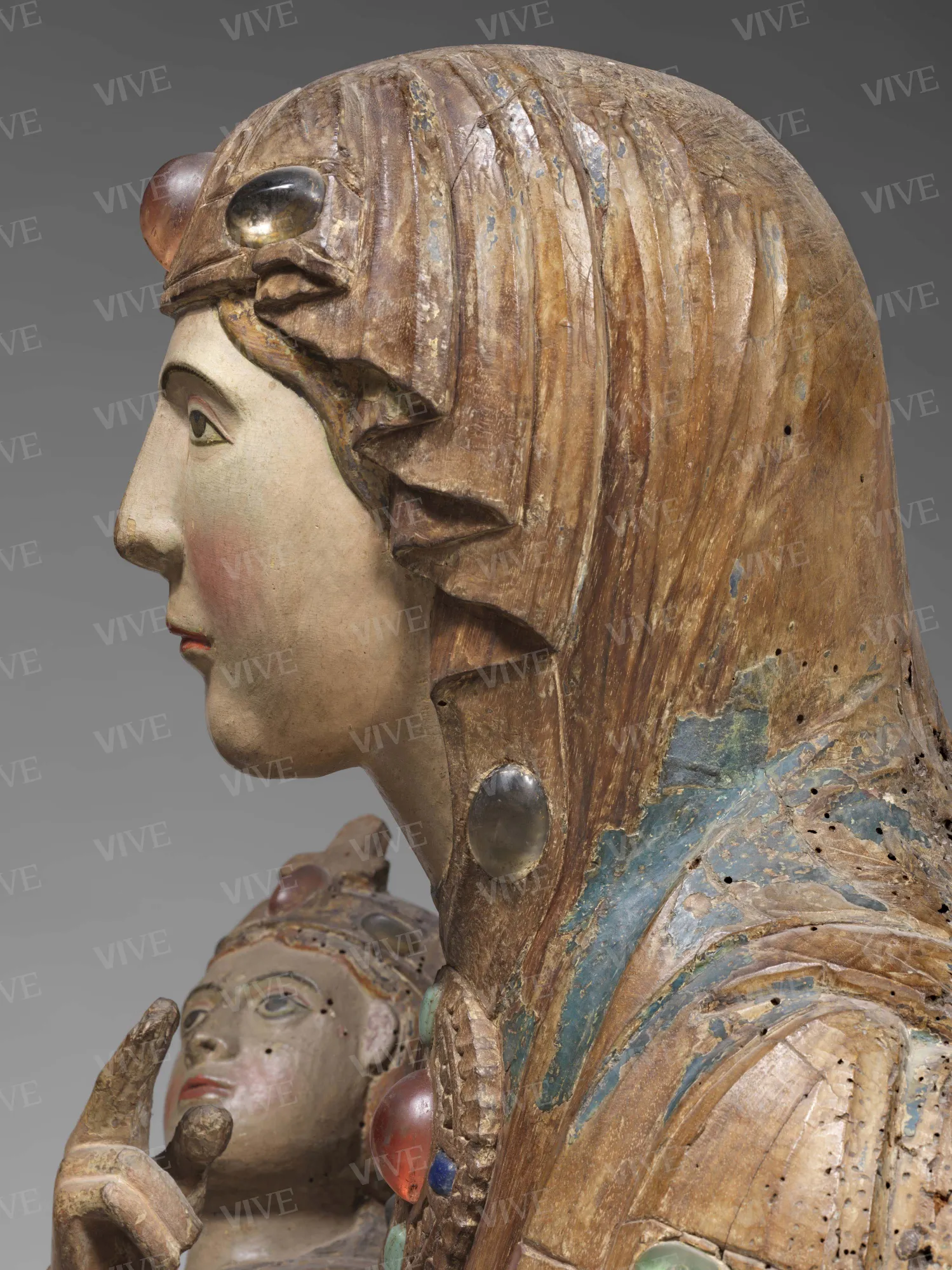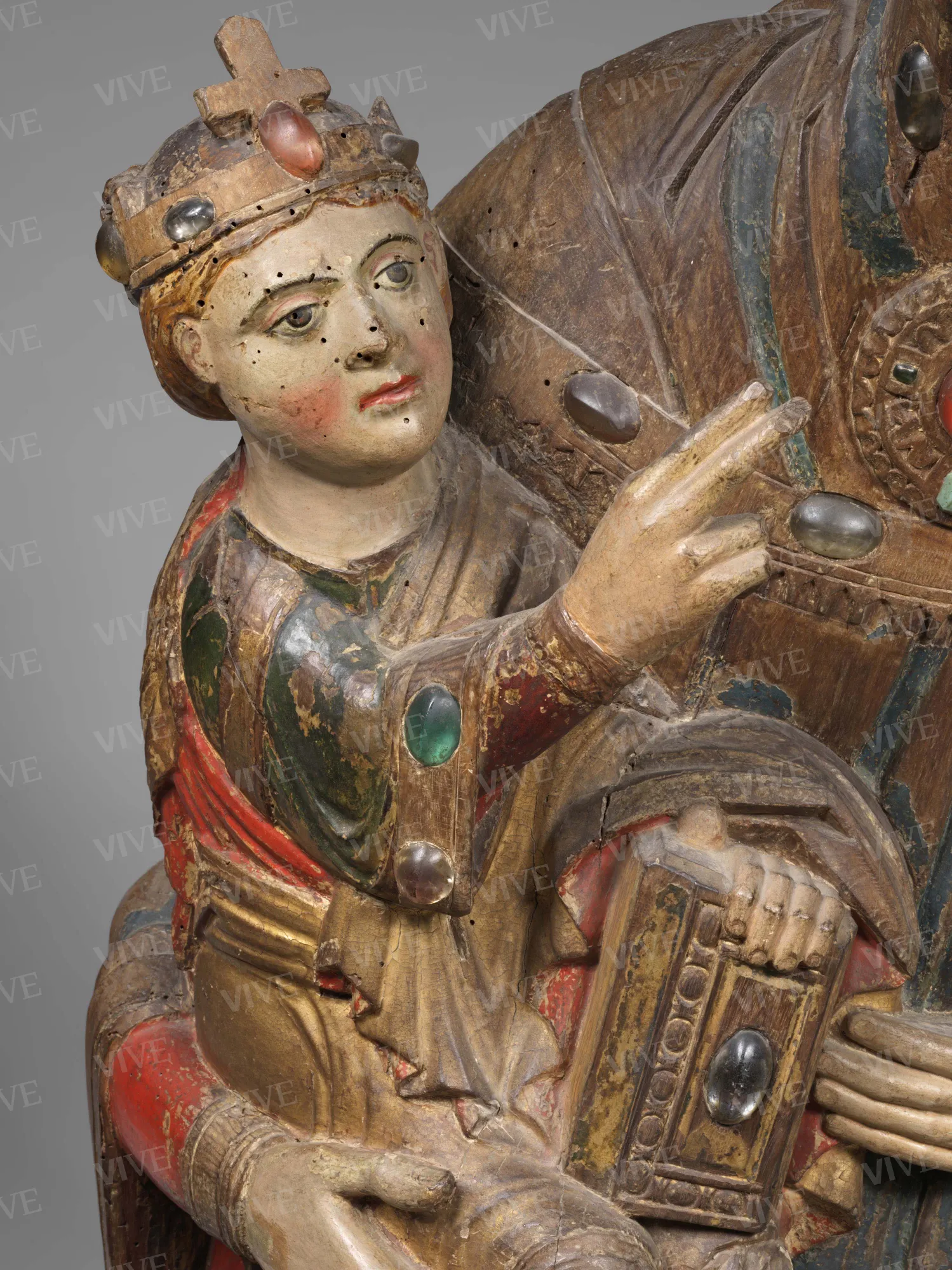Madonna Enthroned and Child, known as the Madonna of Acuto
Central Italian milieu Early-13th century
The polychrome wooden sculpture depicts the Virgin, in rigid frontal seated pose, holding the Blessing Child with her right arm. The Child is depicted in three-quarter-length and is wearing a clavate tunic, a cloak, and a crown. He is using his left hand to firmly hold against his knee a book with a large glass ornament set in the cover. The Virgin is wearing a tunic and cloak, which is decorated with numerous glass ormaments set in bezels and held in place on the breast by a kind of disc-shaped brooch or fibula. The lower base has been restored.
The polychrome wooden sculpture depicts the Virgin, in rigid frontal seated pose, holding the Blessing Child with her right arm. The Child is depicted in three-quarter-length and is wearing a clavate tunic, a cloak, and a crown. He is using his left hand to firmly hold against his knee a book with a large glass ornament set in the cover. The Virgin is wearing a tunic and cloak, which is decorated with numerous glass ormaments set in bezels and held in place on the breast by a kind of disc-shaped brooch or fibula. The lower base has been restored.
Details of work
Catalog entry
The polychrome wooden sculpture was purchased in 1920 by Federico Hermanin for the newly established Museo di Palazzo Venezia, where it has continuously been exhibited as one of the collection's identifying works. The sculpture’s history in Acuto, a town in the then Roman countryside and now in the province of Frosinone, is uncertain. At the time of its transfer to Rome, the work was held in the church of Santa Maria Assunta, where it had been brought from the church of San Sebastiano with a valuable but more recent (perhaps fourteenth-century) metal crown on the Virgin's head (the crown is now in storage). As the sculpture is hollow and unworked in the back, it is assumed that it was originally placed in a "closet" provided with doors or in a niche.
The use of the disc-shaped fibula bezel as a reliquary is also uncertain. In the 1967 restoration it was found to be empty (Brugnoli 1967; Brugnoli 1968), but its use as a reliquary would be highly likely considering coeval and earlier works, especially from countries north of the Alps. More recently, however, though again with no conclusive evidence, it has been argued (Fachechi 2011) that, as with the other bezels, this bezel was only used for a decorative purpose.
The sculpture immediately attracted much attention, especially because of its excellent state of conservation. In 1967, restorers removed the extensive repainting over the flesh tones and the Virgin’s cloak, revealing a pictorial surface that—with the exception of the gold-leaf gilding that was added even later—some scholars (Brugnoli 1967; Brugnoli 1968) dated to the fourteenth century, while others (Fachechi 2011; Fachechi 2012) considered original. The present polychromy is distinguished by the use of particularly valued pigments applied to a preparation of gesso and animal glue: cinnabar for the reds, mixed with white lead for the complexions; azurite for the blues; and a copper-based pigment mixed with orpiment for the greens. As for the “gems” that adorn the garments, recent analyses have shown that the recesses do not house gemstones, as was once believed at least for those on the sides of the fibula, but opacified colored glass: in fact, cobalt was found to be present in the blues and copper in the greens (Fachechi, Bracci 2019). These embedded glass ornaments are the only ones still in their original location, unlike the others that seem to have been replaced quite early on (Brugnoli 1967; Brugnoli 1968).
The Madonna of Acuto has been included within a group of polychrome wooden sculptures from the Roman countryside, centered on the so-called Madonna of Constantinople from the church of Santa Maria Maggiore in Alatri and also consisting of the Madonnas of Vico in Lazio (church of San Martino), of the sanctuary of Mentorella and, finally, Subiaco (church of Santa Maria della Valle). The relationship between these works—in terms of chronology, typology, and art history—still remains a hotly debated issue, the Madonna of Acuto sometimes being considered the earliest (de Francovich 1937; de Francovich 1943; Brugnoli 1967; Brugnoli 1968) and sometimes the most recent (Santangelo 1954) of a "series" that was almost arbitrarily lumped together, but that—even at the macrolevel of iconography—is by no means uniform or standardized (Curzi 2014). Of the five sculptures, in fact, the one from Acuto is the only one with a dexiokratousa Virgin, that is, the Virgin holding the Child with her right arm, which has noble precendents in painted Roman icons (including the early medieval imago antiqua at Santa Francesca Romana and the panels in the church of the Santissimo Nome di Maria and formerly at Sant'Angelo in Pescheria, from the late eleventh to the twelfth century). It is by virtue of these "iconic" antecedents, so obviously referenced in the hieratic pose and the fixed, penetrating gaze, that the Madonna of Acuto has been described as having a Byzantine "substratum" (de Francovich 1943), "tradition" (de' Maffei 1957), and "setting" (Barberini 1988), albeit in addition to (de Francovich 1943) Romanesque elements that lend a marked "plastic vigor" (Curzi 2014) to the figures, cloaked in carefully modeled drapery. The source of these Romanesque elements, according to de Francovich (de Francovich 1937; de Francovich 1943) and others after him, has been unequivocally located in the Po Valley area, thanks to the similarities identified between Lazio sculptural production and Benedetto Antelami's 1196 Virgin of the Adoration of the Magi in the Parma baptistery. In an attempt to better substantiate this hypothesis, examples are cited from beyond the Alps (especially from the Auvergne region) to highlight a common stylistic matrix and from Tuscany-Emilia to illustrate the spread of the Po valley sculptural style as far afield as Rome and Lazio (Brugnoli 1937; Brugnoli 1943). Therefore, though it is possible to establish a probable date of production to as early as the beginning of the thirteenth century, it is not possible to determine where exactly the piece was produced except in the rather broad central Italian area.
Lorenzo Riccardi
Entry published on 12 February 2025
State of conservation
Excellent.
Restorations and analyses
1920: restoration performed by Carmelo Gardini, under the direction of Federico Hermanin;
1967: restoration performed by Aldo Angelini, under the direction of Maria Vittoria Brugnoli;
2009–2011: diagnostic analysis by Grazia Maria Fachechi on the occasion of the new cataloging of wood carvings.
Provenance
Acuto, parish of Santa Maria Assunta;
Museo di Palazzo Venezia, acquired in 1920, finalized in 1932.
Exhibition history
Paris, Petit Palais, Trésors d'art du Moyen Age en Italie, May–July 1952, no. 117;
Milan, Museo Poldi Pezzoli, Sculture lignee medievali, June–July 1957;
Rome, Palazzo Venezia, Sala Barbo, Barbo, Mostra di opere d’arte restaurate nel 1967, April 1968;
Rome, Palazzo Venezia, Imago Mariae. Tesori d’arte della civiltà cristiana, June 20–October 2, 1988;
Ravenna, National Museum, Deomene. L’immagine dell’orante fra Oriente e Occidente, March 25–June 24, 2001.
Sources and documents
Riccardi 2021.
References
Hermanin Federico, Sculture medioevali romane, in «Dedalo», 1, 1920-1921, pp. 217-223;
Hermanin Federico, Il Palazzo di Venezia. Mostre e grandi sale, Bologna 1925, pp. 29-30;
Toesca Pietro, Il Medioevo, Torino 1927, p. 829;
Lavagnino Emilio, Storia dell’arte medioevale italiana, Torino 1936, p. 345;
de Francovich Géza, A Romanesque School of Wood Carvers in Central Italy, in «Art Bulletin», 19, 1937, pp. 4-57;
de Francovich Géza, Scultura medioevale in legno, Roma 1943, pp. 12-13;
Hermanin Federico, L’Arte in Roma dal secolo VIII al XIV, Bologna 1945, pp. 145-147, 150, 230, 364;
Santangelo Antonino, Il Museo di Palazzo Venezia. Catalogo delle sculture, Rome 1954, p. 24;
de’ Maffei Fernanda, in Mostra delle sculture lignee medioevali, catalogo della mostra (Milano, Museo Poldi Pezzoli, giugno-luglio 1957), Milano 1957, p. 21, n. 4;
Carli Enzo, Scultura lignea italiana, Milano 1960, p. 29;
Toesca Ilaria, La Madonna di Santa Maria della Valle a Subiaco, in «Bollettino d’arte», 49, 1964, pp. 218-219;
Brugnoli Maria Vittoria, Museo di Palazzo Venezia. Prima metà sec. XIII: Madonna con bambino detta “di Acuto”, in «Bollettino d’Arte», s. V, 52, 1967, p. 250;
Brugnoli Maria Vittoria, in Mostra di opere d’arte restaurate nel 1967. Soprintendenza alle Gallerie e alle Opere d’Arte medioevali e moderne del Lazio, catalogo della mostra (Roma, Palazzo Venezia, Sala Barbo, aprile 1968), Roma 1968, pp. 5-7, n. 1;
Ticconi Maria, La Madonna di Acuto, in «Terra Nostra», 17, 1978, 11-12, pp. 27-28;
Barberini, in Amato Pietro (a cura di), Imago Mariae. Tesori d’arte della civiltà cristiana, catalogo della mostra (Roma, Palazzo Venezia, 20 giugno-2 ottobre 1988), Milano 1988, pp. 79-80, n. 24;
Nicita, in Donati Angela, Gentile Giovanni (a cura di), Deomene. L’immagine dell’orante fra Oriente e Occidente, catalogo della mostra (Ravenna, Museo Nazionale, 25 marzo-24 giugno 2001), Milano, p. 206, cat. 1;
Fachechi Grazia Maria, Museo Nazionale del Palazzo di Venezia. Sculture in legno, Roma 2011, pp. 71-74, n. 1;
Fachechi Grazia Maria, Di legno e d’oro, d’azzurrite e di cinabro: la romanica Madonna di Acuto e il suo statuto di oggetto di transizione, in Cappelletti Francesca et alii (a cura di), Le due Muse. Scritti d’arte, collezionismo e letteratura in onore di Ranieri Varese, Ancona 2012, pp. 216-227;
Curzi Gaetano, Origine e diffusione delle Madonne in Maestà in Italia centromeridionale: il caso di Alatri tra Lazio e Campania, in Leone de Castris Pierluigi (a cura di), Sculture in legno a Napoli e in Campania fra Medioevo ed età moderna, Atti del convegno (Napoli, 4-5 novembre 2011), Napoli 2014, pp. 24-36 (pp. 24-26);
Fachechi Grazia Maria, Bracci Susanna, Romanesque Polychrome Wood Sculptures in Italy: Towards a Corpus and a Comparative Analysis of the Data from Arthistorical and Technical Studies, in «Medievalista», 26, 2019 [On line] [Consultato il 13/08/2022]. Link: http://www2.fcsh.unl.pt/iem/medievalista/MEDIEVALISTA26/fachechibracci2603;
Riccardi Lorenzo, Circondata di rispetto e protezione: per una storia della tutela della scultura lignea medievale nel Frusinate, in Angelelli Walter, Pomarici Francesca, Tra Chiesa e Regno: nuove ricerche sull’arte del Basso Medioevo nel Frusinate, Roma 2021, vol. II, pp. 409-454 (pp. 429-433).

